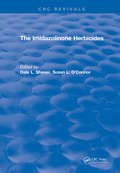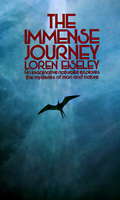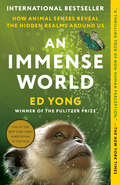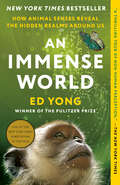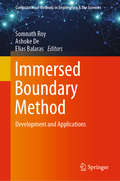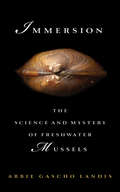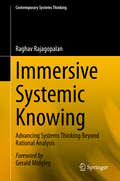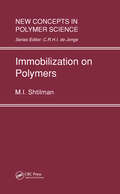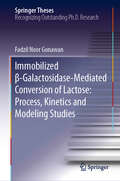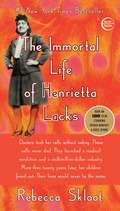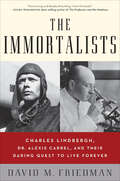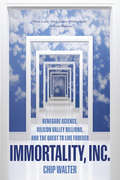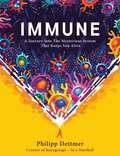- Table View
- List View
Imidazoline Inhibitors for Corrosion Protection of Oil Pipeline Steels: Experimental Laboratory Evaluation and Case Studies
by Faysal Fayez EliyanImidazoline Inhibitors for Corrosion Protection of Oil Pipeline Steels Comprehensive and consolidated resource covering the evaluation of imidazoline inhibitors for safeguarding pipeline steels against corrosion, with supporting case studies Imidazoline Inhibitors for Corrosion Protection of Oil Pipeline Steels represents a comprehensive compilation of the experimental findings that delve into the evaluation of imidazoline inhibitors for safeguarding pipeline steels against corrosion, consolidating invaluable insights and discoveries from a multitude of investigations. The experimental methodologies employed encompass a diverse range of techniques, enabling a thorough exploration of the inhibitive properties of imidazoline compounds. The book explores the significance of various corrosion control strategies, including the utilization of a variety of inhibitors, the implementation of pigging techniques, the application of cathodic protection, and the relevant codes and standards. To aid in reader comprehension, the book presents a collection of comprehensive case studies focusing on the corrosion control challenges faced by oil pipeline companies in operations. These case studies incorporate the details of managing pipelines with high gas content, considering factors such as temperature, flow regime, water content, and steel type. Each case study examines realistic parameters, operation conditions, and provides detailed procedures for protecting, monitoring, and evaluating the performance of corrosion control measures. Sample topics covered in Imidazoline Inhibitors for Corrosion Protection of Oil Pipeline Steels include: Scanning electron microscopy (SEM) and profilometry, transmission electron microscopy (TEM), and scanning Kelvin probe force microscopy (SKPFM) X-ray photoelectron spectroscopy (XPS), wire beam electrode (WBE), atomic force microscopy characterization (AFM), and polarization modulation infrared reflection absorption spectroscopy (PM-IRRAS) Influence of physicochemical and flow effects, as well as metallurgical and surface effects, on corrosion inhibition and environmental and operational conditions Computational studies, such as molecular dynamic simulations and Monte Carlo simulations, density functional theory, and radial distribution function (RDF) A comprehensive and consolidated resource for understanding the experimental evaluation of imidazoline inhibitors on oil pipeline steels, Imidazoline Inhibitors for Corrosion Protection of Oil Pipeline Steels serves as a vital reference for corrosion scientists, engineers, and researchers, offering knowledge and insights to enhance the corrosion protection strategies employed in the oil and gas industry.
The Imidazolinone Herbicides (CRC Press Revivals)
by Dale L Shaner Susan L O'ConnorThis book presents detailed information on the imidazolinone herbicides, provided in chapters contributed by scientists and product development managers who work for American Cyanamid, categorized in sections covering chemistry, biology, metabolism and residues, environmental fate and product performance. Each chapter has its own bibliography, and appendices give (a) details of the chemical and physical properties, formulations and trade names of imazapyr, imazamethabenz-methyl, imazethapyr and imazaquin, and (b) the scientific and common names of species used in the text. There is a general bibliography of references for each of the above imidazolinone herbicides and a useful subject index. The individual chapters are abstracted separately.
The Immense Journey
by Loren C. EiseleyAnthropologist and naturalist Loren Eiseley blends scientific knowledge and imaginative vision in this story of man.
An Immense World: How Animal Senses Reveal the Hidden Realms Around Us
by Ed YongEnter a new dimension—the world as it is truly perceived by other animals—from the Pulitzer Prize-winning, New York Times bestselling author of I Contain Multitudes.&“A stunning achievement, steeped in science but suffused with magic.&”—Siddhartha Mukherjee, author of The GeneThe Earth teems with sights and textures, sounds and vibrations, smells and tastes, electric and magnetic fields. But every kind of animal, including humans, is enclosed within its own unique sensory bubble, perceiving but a tiny sliver of our immense world. In An Immense World, author and Pulitzer Prize–winning science journalist Ed Yong coaxes us beyond the confines of our own senses, allowing us to perceive the skeins of scent, waves of electromagnetism, and pulses of pressure that surround us. We encounter beetles that are drawn to fires, turtles that can track the Earth&’s magnetic fields, fish that fill rivers with electrical messages, and even humans who wield sonar like bats. We discover that a crocodile&’s scaly face is as sensitive as a lover&’s fingertips, that the eyes of a giant squid evolved to see sparkling whales, that plants thrum with the inaudible songs of courting bugs, and that even simple scallops have complex vision. We learn what bees see in flowers, what songbirds hear in their tunes, and what dogs smell on the street. We listen to stories of pivotal discoveries in the field, while looking ahead at the many mysteries that remain unsolved. Funny, rigorous, and suffused with the joy of discovery, An Immense World takes us on what Marcel Proust called &“the only true voyage . . . not to visit strange lands, but to possess other eyes.&”
An Immense World: How Animal Senses Reveal the Hidden Realms Around Us
by Ed YongEnter a new dimension—the world as it is truly perceived by other animals—from the Pulitzer Prize-winning, New York Times bestselling author of I Contain Multitudes. <p><p> The Earth teems with sights and textures, sounds and vibrations, smells and tastes, electric and magnetic fields. But every kind of animal, including humans, is enclosed within its own unique sensory bubble, perceiving but a tiny sliver of our immense world. <p><p>In An Immense World, author and Pulitzer Prize–winning science journalist Ed Yong coaxes us beyond the confines of our own senses, allowing us to perceive the skeins of scent, waves of electromagnetism, and pulses of pressure that surround us. We encounter beetles that are drawn to fires, turtles that can track the Earth’s magnetic fields, fish that fill rivers with electrical messages, and even humans who wield sonar like bats. <p><p>We discover that a crocodile’s scaly face is as sensitive as a lover’s fingertips, that the eyes of a giant squid evolved to see sparkling whales, that plants thrum with the inaudible songs of courting bugs, and that even simple scallops have complex vision. <p><p>We learn what bees see in flowers, what songbirds hear in their tunes, and what dogs smell on the street. We listen to stories of pivotal discoveries in the field, while looking ahead at the many mysteries that remain unsolved. <p><p>Funny, rigorous, and suffused with the joy of discovery, An Immense World takes us on what Marcel Proust called “the only true voyage . . . not to visit strange lands, but to possess other eyes.” <p> <b>New York Times Bestseller</b>
Immersed Boundary Method: Development and Applications (Computational Methods in Engineering & the Sciences)
by Somnath Roy Ashoke De Elias BalarasThis volume presents the emerging applications of immersed boundary (IB) methods in computational mechanics and complex CFD calculations. It discusses formulations of different IB implementations and also demonstrates applications of these methods in a wide range of problems. It will be of special value to researchers and engineers as well as graduate students working on immersed boundary methods, specifically on recent developments and applications. The book can also be used as a supplementary textbook in advanced courses in computational fluid dynamics.
Immersion: The Science and Mystery of Freshwater Mussels
by Abbie Gascho LandisAbbie Gascho Landis first fell for freshwater mussels while submerged in an Alabama creek, her pregnant belly squeezed into a wetsuit. After an hour of fruitless scanning, a mussel materialized from the rocks—a little spectaclecase, herself pregnant, filtering the river water through a delicate body while her gills bulged with offspring. In that moment of connection, Landis became a mussel groupie, obsessed with learning more about the creatures' hidden lives. She isn't the only fanatic; the shy mollusks, so vital to the health of rivers around the world, have a way of inspiring unusual devotion.In Immersion: The Science and Mystery of Freshwater Mussels, Landis brings readers to a hotbed of mussel diversity, the American Southeast, to seek mussels where they eat, procreate, and, too often, perish. Accompanied often by her husband, a mussel scientist, and her young children, she learned to see mussels on the creekbed, to tell a spectaclecase from a pigtoe, and to worry what vanishing mussels—70 percent of North American species are imperiled—will mean for humans and wildlife alike. In Immersion, Landis shares this journey, traveling from perilous river surveys to dry streambeds and into laboratories where endangered mussels are raised one precious life at a time.Mussels have much to teach us about the health of our watersheds if we step into the creek and take a closer look at their lives. In the tradition of writers like Terry Tempest Williams and Sy Montgomery, Landis gracefully chronicles these untold stories with a veterinarian's careful eye and the curiosity of a naturalist. In turns joyful and sobering, Immersion is an invitation to see rivers from a mussel's perspective, a celebration of the wild lives visible to those who learn to search.
Immersive Systemic Knowing: Advancing Systems Thinking Beyond Rational Analysis (Contemporary Systems Thinking)
by Raghav RajagopalanThis book advances systems thinking by introducing a new philosophy of systemic knowing. It argues that there are inescapable limits to rational understanding. Humankind has always depended on extended ways of knowing to complement the rational-analytic approach. The book establishes that the application of such methods is fundamental to systemic practice. The author advocates embracing two modes of consciousness: intentionality, which Western philosophy has long recognized, and non-intentional awareness, which Eastern philosophy additionally highlights. The simultaneity of these two modes of consciousness, and the variety of knowings they spawn are harnessed for a more holistic, systemic knowing. Four practices from fields related to systems thinking are examined: two contemporary action research methodologies from the US and the UK; the Sumedhian (Indian) approach to inquiry about processes within groups; and a technique of group psychotherapy originating in Eastern Europe. Each of these systematically harnesses knowing using both modes of consciousness. Therefore, the author insists, such approaches must be included in systemic practice, in purposeful and methodical juxtaposition to rational-analytic ways. The book provides examples and guidelines for deployment.“All researchers and practitioners of systems thinking and action research must read this book...Raghav has craftfully blended Eastern and Western wisdom. He uses his immersion into Eastern ways of knowing practically, to elaborate the systems philosophy in rich detail. He has incorporated, from cooperative inquiry as action research, the idea of four ways of knowing: practical, propositional, presentational and experiential, to bolster the foundations of systems thinking”―SHANKAR SANKARAN, Professor, University of Technology Sydney, Australia; President International Society of Systems Sciences (ISSS) 2019-2020“This is a book with the potential to stimulate the emergence of a new paradigm. Raghav shows that systems thinking can transcend rational analysis and incorporate other ways of knowing, such as arts-based methods… also, rather than be overly preoccupied with striving for change, there is value in simply abiding, which comes with a deep appreciation of the ecological relationships we are part of. It’s not that rational analysis is wrong – it’s that it is only part of a genuinely transformative practice”. ―GERALD MIDGLEY, Co-Director, Centre for Systems Studies, University of Hull; former President, ISSS (2013-14)“Raghav Rajagopalan’s writing on generating deep appreciation for the social and ecological interdependencies ties in closely with my own work. The philosophical ideas he develops contain the tracings and essential tones of Gregory Bateson’s idea of "Mind" as a process of living complexities reaching well beyond the notion of the body. This book demonstrates outstanding erudition and deep compassion at the same time. It should delight the adventurous reader unafraid of big questions”.―NORA BATESON, President of the International Bateson Institute
Imminent Science
by Giovanni F. BignamiThis is not science fiction. It's a voyage on the arrow of time to the coming fifty years. The legendary palindromic character Mr. Qfwfq from Italo Calvino's collection of short stories, The Cosmicomics, will go with us - he who knows all the answers but will give out no hints. He will help us to discover the innovations that will have changed our lives by 2062, when, riding astride Halley's Comet, our omniscient extraterrestrial will return to visit us. In this book, we shall learn how astronomers will devote themselves to the study of the mysterious force of dark energy, which makes up some three-quarters of the Universe. We shall also delve deeply into the study of our Earth, to exploit the immense thermal energy that lies beneath our feet. We shall solve another enigma in today's science: the origin of life. We shall come to understand how to develop direct contacts between our brains and the rest of the world. We shall learn about the future of genetics, the reason for the longevity of Methuselah flies and the quest for prime numbers. These are only some of the exciting and important discoveries to be revealed in this intriguing book, which is designed for a broader public and not only for science fiction devotees.
Immittance Spectroscopy: Applications to Material Systems
by Mohammad A. AlimThis book emphasizes the use of four complex plane formalisms (impedance, admittance, complex capacitance, and modulus) in a simultaneous fashion. The purpose of employing these complex planes for handling semicircular relaxation using a single set of measured impedance data (ac small-signal electrical data) is highly underscored. The current literature demonstrates the importance of template version of impedance plot whereas this book reflects the advantage of using concurrent four complex plane plots for the same data. This approach allows extraction of a meaningful equivalent circuit model attributing to possible interpretations via potential polarizations and operative mechanisms for the investigated material system. Thus, this book supersedes the limitations of the impedance plot, and intends to serve a broader community of scientific and technical professionals better for their solid and liquid systems. This book addresses the following highlighted contents for the measured data but not limited to the:- (1) Lumped Parameter/Complex Plane Analysis (LP/CPA) in conjunction with the Bode plots; (2) Equivalent circuit model (ECM) derived from the LP/CPA; (3) Underlying Operative Mechanisms along with the possible interpretations; (4) Ideal (Debye) and non-ideal (non-Debye) relaxations; and (5) Data-Handling Criteria (DHC) using Complex Nonlinear Least Squares (CNLS) fitting procedures.
Immobilization of Enzymes and Cells
by Gordon BickerstaffThis collection of today's most significant immobilization methods reproduces those procedures currently and widely used in both industrial and research laboratories. These unfailingly reproducible techniques are so crafted that users can easily incorporate them into their existing methods and processes. Extensive notes provide additional information that helps extend the flexibility of the method.
Immobilization of Enzymes and Cells
by José M. GuisánThe second edition of Immobilization of Enzymes and Cells serves as an update as well as a compliment to the first edition. This volume now includes simple protocols for the immobilization of enzymes and cells that could be useful for application at industrial scale, novel protocols for immobilization in the future, and new chemical reactors able to overcome the limitations of a number of immobilized derivatives.
Immobilization of Enzymes and Cells: Methods and Protocols (Methods in Molecular Biology #2100)
by Jose M. Guisan Juan M. Bolivar Fernando López-Gallego Javier Rocha-MartínThis fourth edition volume expands on the previous editions with new insights on important aspects to take into accounting when immobilizing enzymes and cells, illustrating outstanding examples that support those aspects, and exploring ways to fabricate and characterize heterogeneous biocatalysts including both immobilized enzymes and cells. The transformation of soluble and usually instable enzymes into heterogeneous and highly stable biocatalysts is strongly emphasized. The chapters in this book cover topics such as the importance of enzyme orientation on the support surface; application and characterization of immobilized enzymes; different functionalization chemistries for the modulation of the immobilized enzyme properties; co-immobilization of multi-enzyme systems; new analytical techniques for the characterization of heterogeneous biocatalysts; protocols for cell entrapment in alginate; preparation and characterization of biofilms; and cell encapsulation technologies. Written in the highly successful Methods in Molecular Biology series format, chapters include introductions to their respective topics, lists of the necessary materials and reagents, step-by-step, readily reproducible laboratory protocols, and tips on troubleshooting and avoiding known pitfalls.Cutting-edge and authoritative, Immobilization of Enzymes and Cells: Methods and Protocols, Fourth Edition is a valuable resource for researchers interested in expanding their knowledge of this developing field.
Immobilization on Polymers
by M.I. ShtilmanThis volume is devoted to the developments in the branch of polymer chemistry which deals with immobilized systems. These systems are widely used in fields connected with metabolism in humans, animals, plants and micro-organisms. The study of these artificial immobilized systems permits the understanding and design of the function and behaviour of natural substances in living organisms. The book contains the latest achievements in the field of synthesis of polymeric derivatives of different natural substances such as: proteins; peptides; amino acids; poly- and monosaccharides; nucleic acids; nucleosides; nucleotides; coenzymes; vitamines; alkaloids; antibiotics; steroids; hormones; and others. Special attention is given to natural and synthetic carriers and the influence of their chemical structure on the efficiency of systems obtained. This work should be of value and interest to researchers in the field of polymer chemistry, biotechnology and genetic engineering, medical chemistry, bio-organic chemistry and enzymology.
Immobilization Strategies: Biomedical, Bioengineering and Environmental Applications (Gels Horizons: From Science to Smart Materials)
by Anuj Tripathi Jose Savio MeloThis book delves into the field of immobilizing biologically active and non-active molecules. It discusses the designing strategy of immobilization and the current state-of-the-art applications for advancing biomedical, agricultural, environmental and industrial practices. It focuses on aspects ranging from fundamental principles to current technological advances at multi-scale levels (macro, micro, and nano) which are suitable for cell, enzyme, and nano-catalyst based applications. Written by experts from across the globe, the contents deal with illustrated examples of molecular and cellular interactions with materials/scaffolds and discussions on factors that can affect the functionality and yield of the process. With its discussions on material science, design of delivery vehicles, separation science, additive manufacturing, agriculture and environmental science, this book will be a useful reference for researchers across multiple disciplines.
Immobilized β-Galactosidase-Mediated Conversion of Lactose: Process, Kinetics and Modeling Studies (Springer Theses)
by Fadzil Noor GonawanThis book describes the reaction rate profiles of the β-galactosidase-catalyzed conversion of lactose on the inner surface of a hollow fiber membrane, which is employed as an enzymatic reactor system. The reaction rate profiles were obtained by solving the mass transfer and kinetics of reaction in a 2-dimensional model of the system. The primary challenge of this research was to develop the kinetic model of the reaction to describe the kinetic behavior as the reaction occurred on the membrane surface. Despite the difficulties, the proposed model can reliably replicate the actual process, as validation procedures have confirmed. The reaction rates obtained analyze the performance of the immobilized enzyme on the membrane surface. Previously, an increase in performance of 'β-galactosidase-catalyzed conversion of lactose assisted by ultrafiltration was suggested due to inhibitor removal. However, as the analysis presented here shows, the concentration profile of the substrate on the membrane surface also affects the reaction performance.
Immobilized Cells and Organelles: Volume I
by MattiassonCells and organelles are small units for biochemical synthetic purposes, often the smallest practically feasible unit since they contain coenzyme regenerating system, ordered enzyme sequences, etc.These volumes, besides giving some insight into basic technology (immobilisation procedures, etc.), also sum up the current know-how in this subject area and try to predict some future trends.The termimmobilized cells covers everything from dead cells with a single active enzyme species to cells proliferating on or within a three dimensional polymer matrix. The practical handling of these structures make them useful in various applications, e.g. large-scale production of biomolecules, biodegration, analysis, etc.
Immobilized Cells and Organelles: Volume II
by MattiassonCells and organelles are small units for biochemical synthetic purposes, often the smallest practically feasible unit since they contain coenzyme regenerating system, ordered enzyme sequences, etc.These volumes, besides giving some insight into basic technology (immobilisation procedures, etc.), also sum up the current know-how in this subject area and try to predict some future trends.The termimmobilized cells covers everything from dead cells with a single active enzyme species to cells proliferating on or within a three dimensional polymer matrix. The practical handling of these structures make them useful in various applications, e.g. large-scale production of biomolecules, biodegration, analysis, etc.
Immobilized Enzymes for Food Processing
by PitcherMuch has been written about immobilized enzymes during this period of time. So much, in fact, that it can become difficult even for those involved in developing new enzymatic food processing operations to bridge the gap between the field of immobilized enzymes and their specific requirements. It is the purpose of this book to assist those engaged in this difficult task. It is also a goal to bring to the researcher in enzyme immobilization an appreciation for the requirements of the food processing industry.
The Immortal life of Henrietta Lacks
by Rebecca Skloot<P>Her name was Henrietta Lacks, but scientists know her as HeLa. She was a poor Southern tobacco farmer who worked the same land as her slave ancestors, yet her cells-taken without her knowledge-became one of the most important tools in medicine. <P>The first “immortal” human cells grown in culture, they are still alive today, though she has been dead for more than sixty years. If you could pile all HeLa cells ever grown onto a scale, they’d weigh more than 50 million metric tons-as much as a hundred Empire State Buildings. HeLa cells were vital for developing the polio vaccine, uncovered secrets of cancer, viruses, and the atom bomb’s effects; helped lead to important advances like in vitro fertilization, cloning, and gene mapping; and have been bought and sold by the billions. Yet Henrietta Lacks remains virtually unknown, buried in an unmarked grave. <P>Now Rebecca Skloot takes us on an extraordinary journey, from the “colored” ward of Johns Hopkins Hospital in the 1950s to stark white laboratories with freezers full of HeLa cells; from Henrietta’s small, dying hometown of Clover, Virginia-a land of wooden slave quarters, faith healings, and voodoo-to East Baltimore today, where her children and grandchildren live and struggle with the legacy of her cells. <P>Henrietta’s family did not learn of her “immortality” until more than twenty years after her death, when scientists investigating HeLa began using her husband and children in research without informed consent. And though the cells had launched a multimillion-dollar industry that sells human biological materials, her family never saw any of the profits. As Rebecca Skloot so brilliantly shows, the story of the Lacks family-past and present-is inextricably connected to the dark history of experimentation on African Americans, the birth of bioethics, and the legal battles over whether we control the stuff we are made of. <P>Over the decade it took to uncover this story, Rebecca became enmeshed in the lives of the Lacks family-especially Henrietta’s daughter Deborah, who was devastated to learn about her mother’s cells. She was consumed with questions: Had scientists cloned her mother? Did it hurt her when researchers infected her cells with viruses and shot them into space? What happened to her sister, Elsie, who died in a mental institution at the age of fifteen? And if her mother was so important to medicine, why couldn’t her children afford health insurance? <P>Intimate in feeling, astonishing in scope, and impossible to put down,The Immortal Life of Henrietta Lackscaptures the beauty and drama of scientific discovery, as well as its human consequences. <P><b>A New York Times Bestseller</b>
The Immortalists: Charles Lindbergh, Dr. Alexis Carrel, and Their Daring Quest to Live Forever
by David M. FriedmanHis historic career as an aviator made Charles Lindbergh one of the most famous men of the twentieth century, the subject of best-selling biographies and a hit movie, as well as the inspiration for a dance step—the Lindy Hop—that he himself was too shy to try. But for all the attention lavished on Lindbergh, one story has remained untold until now: his macabre scientific collaboration with Dr. Alexis Carrel. This oddest of couples—one a brilliant Nobel Prize-winning surgeon turned social engineer, the other a failed dirt farmer turned hero of the skies—joined forces in 1930 driven by a shared and secret dream: to conquer death and attain immortality.Part Frankenstein, part The Professor and the Madman, and all true, The Immortalists is the remarkable story of how two men of prodigious achievement and equally large character flaws challenged nature's oldest rule, with consequences—personal, professional, and political—that neither man anticipated.
Immortality, Inc.: Renegade Science, Silicon Valley Billions, and the Quest to Live Forever
by Chip WalterThis gripping narrative explores today's scientific pursuit of immortality, with exclusive visits inside Silicon Valley labs and interviews with the visionaries who believe we will soon crack into the aging process and cure death.We live in an age when billionaires are betting their fortunes on laboratory advances to prove aging unnecessary and death a disease that can be cured. Researchers are delving into the mysteries of stem cells and the human genome, discovering what it means to grow old and how to keep those processes from happening. This isn't science fiction; it's real, it's serious, and it's on track to revolutionize our definitions of life and mortality.In Immortality, Inc., veteran science journalist Chip Walter gains exclusive access to the champions of this radical cause, delivering a book that brings together for the first time the visions of molecular biologist and Apple chairman Arthur Levinson, genomics entrepreneur Craig Venter, futurist Ray Kurzweil, rejuvenation trailblazer Aubrey de Grey, and stem cell expert Robert Hariri. Along the way, Walter weaves in fascinating conversations about life, death, aging, and the future of the human race.
The Immortalization Commission
by John GrayA great philosopher will change the way you think about your life.For most of human history, religion provided a clear explanation of life and death. But in the late 19th and early 20th centuries new ideas -- from psychiatry to evolution to Communist -- seemed to suggest that our fate was now in our own hands. We would ourselves become God.This is the theme of a remarkable new book by one of the world's greatest lving philosophers. It is a brilliant and frightening look at the problems and opportunities of a world coming to grips with humankind's now solitary, unaided place in the universe. Gray takes two major examples: the belief that the science-backed Communism of the new USSR could reshape the planet, and the belief among a group of Edwardian intellectuals -- popularized through mediums and automatic writing -- that there was a non-religious form of life after death.Gray presents an extraordinary cast of philosophers, journalists, politicians, charlatans and mass murderers, all of whom felt driven by a specifically scientific and modern world view. He raises a host of fascinating questions about what it means to be human. The implications of Gray's book will haunt its readers for the rest of their lives.From the Hardcover edition.
Immun, fit und gesund – ohne Medikamente: Über 100 Antworten von Ihrem Arzt
by Daniel HarbsIhr Körper ist Ihnen wichtig? Sie suchen die optimale gesunde Lebensführung? Dieser Ratgeber zu Fitness, Weight Loss, Mental Balance, Beauty, Detox und dem Immunsystem gibt fundierte Tipps. Der Allgemeinmediziner Daniel Harbs antwortet kurz und auf den Punkt auf Fragen, die er in seinem Praxisalltag immer wieder hört.Sie wollen fit werden und bleiben, ohne Medikamente einzunehmen? Verwirrt von den Treffern aus Suchmaschinen? Fragen Sie den Experten. Mit Hamburger Nüchternheit, hanseatischem Humor und verständlichen Worten führt der Autor Sie von den Tipps zum Abnehmen, Mittel gegen den Kater, Abwehr von Stress bis zum Umgang mit Gluten, Fett und Zucker. Und wie können wir uns vor Viren schützen, was macht unser Immunsystem stark? Über 125 Fragen und Antworten decken Ihre Neugier und helfen Ihnen auf dem Weg zu einem selbstbestimmt gesünderen Leben.
Immune: The new book from Kurzgesagt - a gorgeously illustrated deep dive into the immune system
by Philipp Dettmer__________Pre-order now: The first book from the creator of the wildly popular science YouTube channel, Kurzgesagt - In a Nutshell, a gorgeously illustrated deep dive into the immune system that will change how you think about your body forever. 'A truly brilliant introduction to the human body's vast system for fighting infections and other threats'JOHN GREEN, #1 New York Times bestselling author of The Fault in Our Stars'Reads as if it's a riveting sci-fi novel . . . a delightful treat for the curious'TIM URBAN, creator of Wait But Why__________You wake up and feel a tickle in your throat. Your head hurts. You're mildly annoyed as you get the kids ready for school and dress for work yourself. Meanwhile, an utterly epic war is being fought, just below your skin. Millions are fighting and dying for you to be able to complain as you drink your cup of tea and head out the door.So what, exactly, IS your immune system?Second only to the human brain in its complexity, it is one of the oldest and most critical facets of life on Earth. Without it, you would die within days. In Immune, Philipp Dettmer, the brains behind the most popular science channel on YouTube, takes readers on a journey through the fortress of the human body and its defences. There is a constant battle of staggering scale raging within us, full of stories of invasion, strategy, defeat, and noble self-sacrifice. In fact, in the time you've been reading this, your immune system has probably identified and eradicated a cancer cell that started to grow in your body.Each chapter delves deeply into an element of the immune system, including defences like antibodies and inflammation as well as threats like viruses, bacteria, allergies and cancer, as Dettmer reveals why boosting your immune system is actually nonsense, how parasites sneak their way past your body's defences, how viruses - including the coronavirus - work, and what goes on in your wounds when you cut yourself.Enlivened by engaging full-colour graphics and immersive descriptions, Immune turns one of the most intricate, interconnected, and confusing subjects - immunology - into a gripping adventure through an astonishing alien landscape.Challenging what you know and think about your own body and how it defends you against all sorts of maladies and how it might also eventually be your own downfall, Immune is a vital and remarkably fun crash course in what is arguably, and increasingly, the most important system in the body.__________

